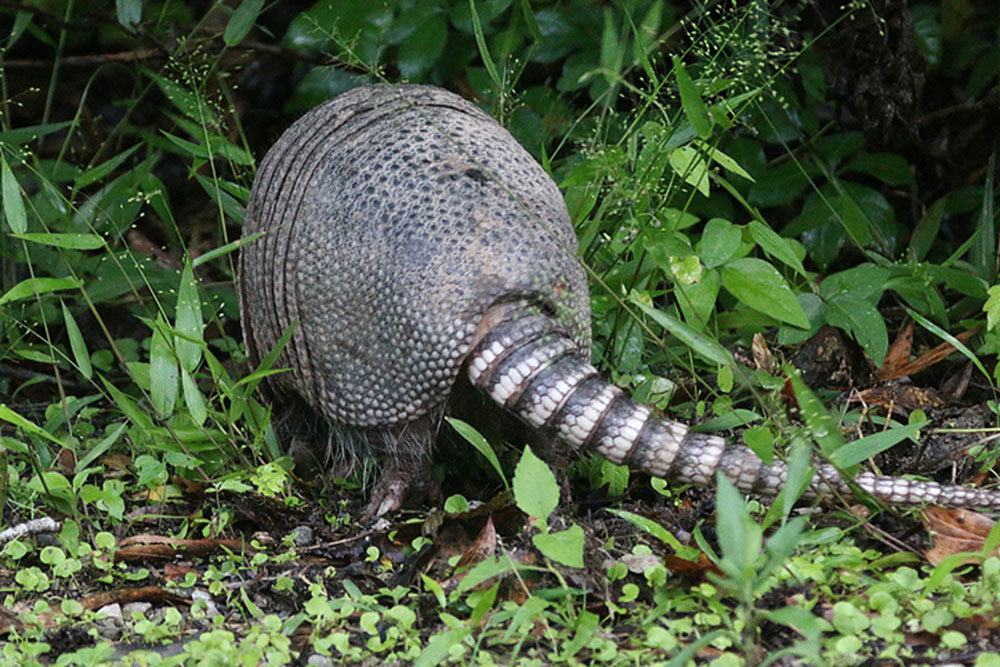
iStock
AFTER THOUGHTFULLY removing a dead armadillo from the bike path on a recent trip in northern Florida, the rider learned from fellow travelers that he might have been exposed to leprosy (also called Hansen’s disease), spurring some worrisome and mostly erroneous comments about the possible risk.
Traditionally, leprosy has been spread only by infected, untreated humans. In recent years, though, in more than a dozen southern states, the disease has become a zoonotic infection traced to the nine-banded armadillo—specifically to very close contact with its meat or blood. It’s the only mammal besides humans that can develop the disease.
Of 150 to 250 people with new cases of leprosy reported each year in the U.S., in addition to about 3,600 people being treated for the chronic condition, some two thirds picked up the bacteria while traveling abroad. But starting in 2011, new cases were reported in people who had been in contact with armadillos—with an “unusually high number of cases cropping up in Florida.”
Contracting Hansen’s disease, caused by Mycobacterium leprae, was thought to require close contact over many months —called an inoculation effect —with an untreated sufferer. Like tuberculosis, leprosy is spread through the air when untreated victims cough or sneeze. Once treatment (usually a combination of two or three antibiotics) begins, they are no longer contagious. However, according to the CDC, a complete cure can take six months or longer on the drugs.
An individual’s risk of contracting leprosy in the U.S. is very low, mostly because up to 95% of Americans are genetically immune to the disease. Also, leprosy cannot be spread through casual contact such as shaking hands or hugging—or sexual contact—or passed during pregnancy from mother to unborn child.
The oldest disease associated with humans, leprosy can produce symptoms as much as seven years after infection. These include lesions that start as red swellings or rash and can become disfiguring; and nerve damage that causes sensory deterioration and can progress to psychosis and seizures. Left untreated, leprosy can be life-threatening.
About two million people around the world are permanently disabled due to Hansen’s disease, and new cases continue to occur in tropical countries—related to poverty, unsanitary conditions and lack of health care for victims before disability occurs and before they pass it along to others. Of about 200,000 new cases reported to the World Health Organization in 2016, 60% were in India, 13% in Brazil and 8% in Indonesia.
Among new cases in the U.S. linked to contact with armadillos, one person had killed the animal and gotten blood on his hands. Another had armadillos digging in her flower beds—the bacteria can survive in moist soil, which is how contagion among armadillos is thought to occur.
In humans, leprosy “needs a cut or mucus membrane to enter into the body,” Richard Truman, chief of research at the National Hansen’s Disease Program in Baton Rouge, Louisiana, told Scientific American. “Just by touching an armadillo you’re not going to get leprosy.”
Americans, in fact, come into frequent contact with millions of armadillos (nocturnal animals that emerge from their burrows to forage at dusk) in the southern U.S. The leathery carapaces are made into purses and boots; the animals are kept as pets or in petting zoos and raced at county fairs; and they are hunted and served as barbecue meat.
Because M.leprae cannot be grown in lab dishes, the discovery of leprosy in armadillos gave researchers their first means for studying the disease. Most likely it’s their body temperature of 90 degrees (cooler than most mammals) that makes armadillos susceptible; scientists believe they were originally infected by humans four or five centuries ago.
Although the numbers of armadillos infected with M.leprae are thought to be around 20% of the population, a 2011 study found that 28 of 33 wild-caught southern armadillos showed evidence of a newly described strain of the bacteria.
In 2000, the World Health Organization declared leprosy officially “eliminated” as a public health problem even as new cases continue to arise. Due to traditional ostracism, those with chronic cases continue to isolate themselves, with more than 700 informal leper colonies in India today.
The one remaining leper colony in the U.S., located on the north coast of the Hawaiian island of Molokai, was once home to thousands of victims who built their own community. By 2015 only six leprosy patients remained. That’s also the case for the few residents choosing to stay in the only U.S. “leprosarium” or in-patient hospital for treating the disease, located in Carville, Louisiana. It closed in 1999 and is now the National Hansen’s Disease Museum.
Based on Florida health reporting, leprosy contracted from armadillos is not on the rise: after 29 and 18 cases in 2015 and 2016 respectively, officials confirmed only 16 cases in 2017.
With armadillos continuing to proliferate, however, and their rustling a familiar nighttime sound in places like Georgia’s Cumberland Island, experts recommend avoiding unnecessary contact.
—Mary Carpenter
Every Tuesday in this space, well-being editor Mary Carpenter reports on health news that affects our everyday lives.
